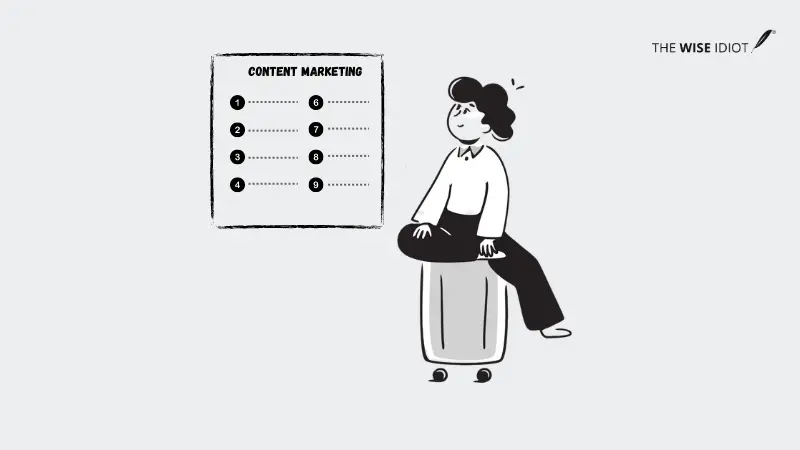Am I bored of shouting into the digital void and not getting the desired engagement? Yes! Worry not; content marketing channels are here to save the day! An overwhelming amount of information is available on the internet, which could make it difficult for your content to reach the intended audience.
A content distribution channel amplifies your message and gets your content in front of the right people. The right distribution channel will help increase brand awareness and reach a larger audience. With ample channels to choose from, you might need help deciding which one to choose.
You could go with the classic social media platforms, like Facebook and Twitter, or you could try something else. Let’s discuss some popular content distribution platforms and which one to choose.
Top 9 Content Distribution Channels
Content distribution channels examples are Facebook ads, email marketing, etc. Let’s understand 10 effective content distribution channels in marketing. You can choose any of these content marketing distribution channels to grow your business.
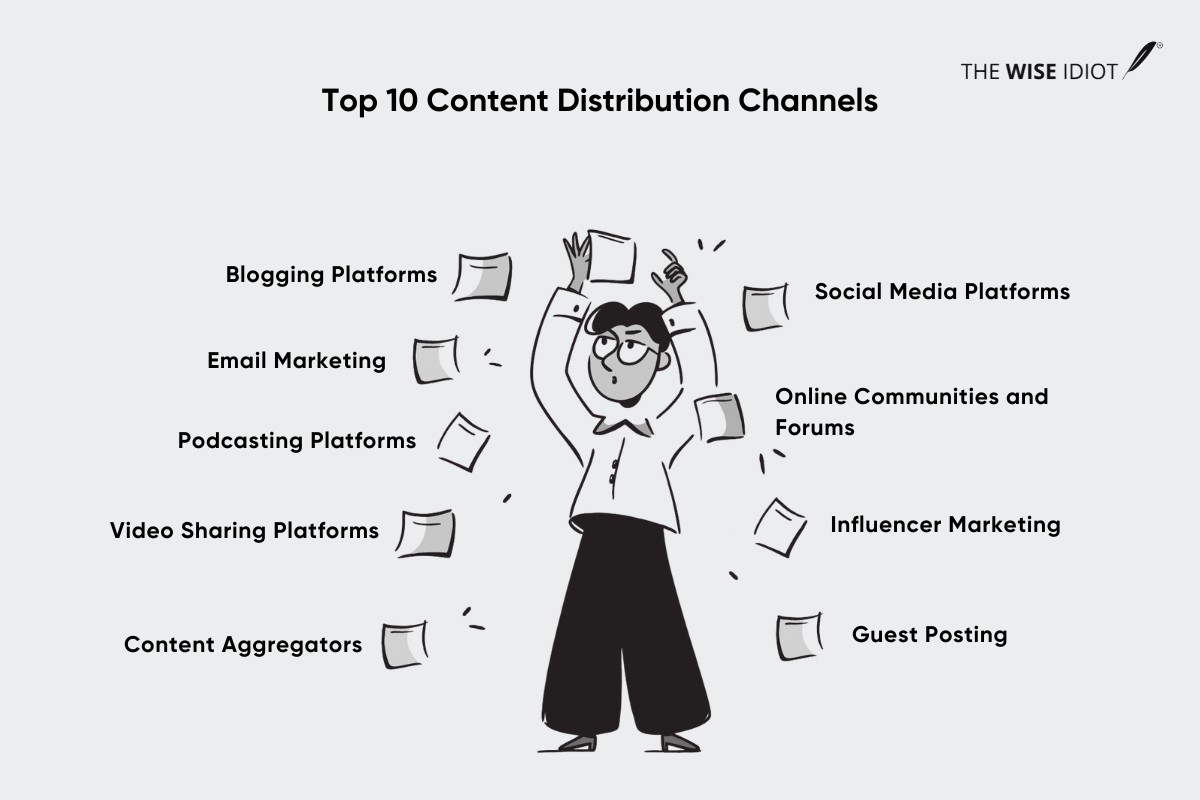
1. Social Media Platforms
Platforms like Facebook, Twitter, Instagram, LinkedIn, and Pinterest are excellent social media distribution channels for sharing content with a wide audience. They allow you to share text, images, videos, and links with your followers and engage with them directly.
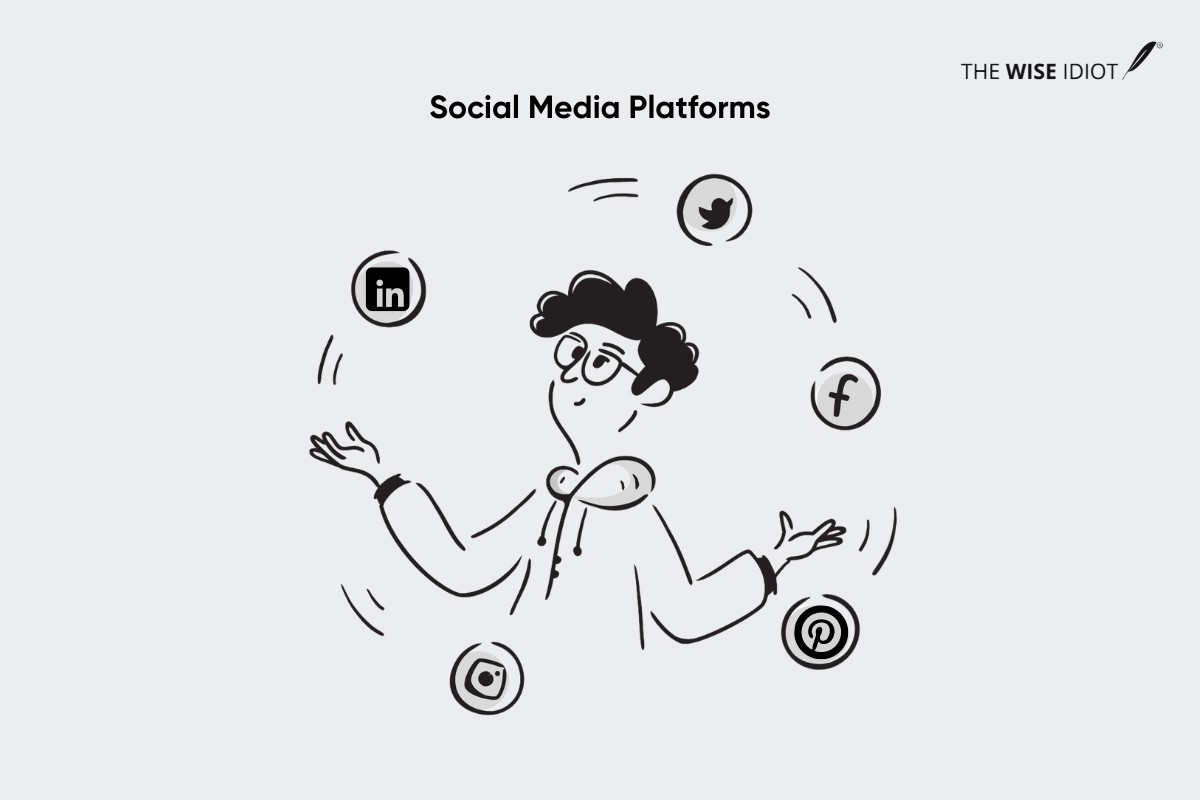
Facebook is important in a brand’s social media distribution strategy. It is one of the biggest social media platforms, with 2.98 billion monthly users. You can create and publish various ads.
They can also opt for creating and sharing reels, the latest phenomenon in advertising. You can also connect your Instagram and Facebook accounts, enabling you to share reels directly from Instagram.
Instagram, originally launched as software for sharing photos, has now become an engagement factory, thanks to reels and videos.
Like Facebook, brands can use this platform to hone their content marketing distribution strategy.
Most ads on this platform are native, meaning they are prescribed to Instagram’s design and function and blend in easily.
Instagram offers businesses a variety of media formats for advertising, including pictures on posts or stories, reels, and videos on their story, as part of their social media distribution strategy.
For example, a travel agency specialising in luxury vacations can leverage Instagram to share visually stunning images, travel experiences, and destination inspirations, building an aspirational brand image.
X (Formally Known as Twitter)
Twitter is a micro-blogging platform that helps business convey their message in as few as 280 characters. Brands of all sizes and scales use Twitter to engage and attract their audiences. It allows users to see photos and videos with a brief caption as a tweet.
Tweeting links to your articles, engaging in industry conversations using relevant hashtags, and retweeting valuable content can be a part of your content distribution strategy.
LinkedIn was launched as a platform for professionals to connect and help people with their job search. Today, it is also useful for brands to post photos, videos, and blogs for their audience. Content shared on LinkedIn is mostly informative and educational.
You can leverage this platform to publish articles on your professional profile, share industry insights, and participate in LinkedIn groups to engage with professionals in your field.
For instance, a B2B SaaS company that publishes thought leadership content and technical articles could prioritise LinkedIn to reach professionals and decision-makers.
On Pinterest, you can distribute your content by sharing it on boards. Boards are collections that store all your Pins and make your content available for your followers to explore. You can create as many boards as you like and organise them based on different themes, ideas, plans, or sources of inspiration. This is convenient for your audience to locate the specific content they are interested in.
Pinterest enables other contributors to add content that aligns with your board’s theme. By doing so, you can foster greater engagement and interaction on your profile, enhancing the overall experience for your audience.
2. Blogging Platforms
Blogging platforms such as WordPress and Medium provide an avenue to publish long-form content. You can create your own blog or contribute to established blogs to reach a specific target audience interested in your industry or niche.
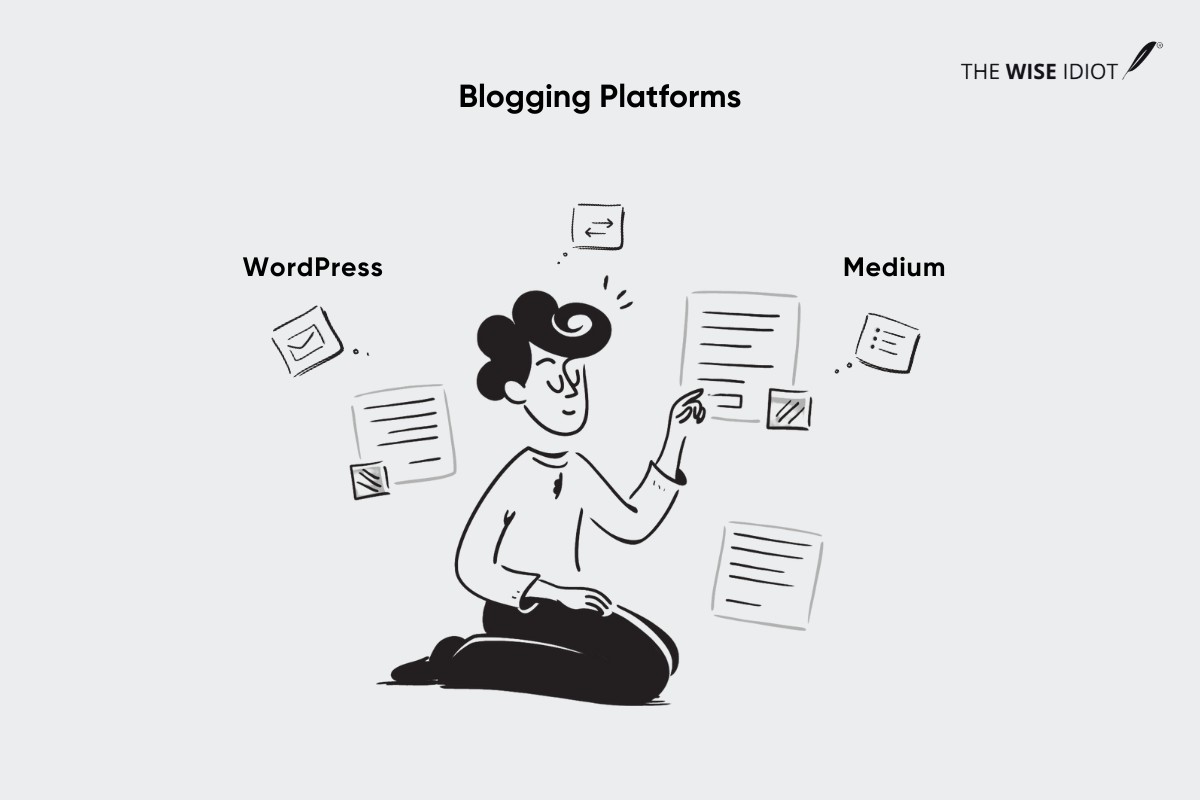
WordPress
WordPress is a versatile content distribution channel allowing users to share content types. It offers customisation options, enabling content organisation into categories and tags. Social sharing features and plugins facilitate content amplification on social media. With built-in SEO capabilities, WordPress helps improve content visibility and attract organic traffic.
Medium
With Medium, you can contribute guest posts to established publications in your niche or start your blog on the platform to reach a wider audience.
3. Email Marketing
Platforms like Mailchimp and ConvertKit help you create an email list allowing you to directly reach your subscribers with valuable content. You can send newsletters, updates, and exclusive content to keep your audience engaged and informed.
Mailchimp
Mailchimp builds an email list for your brand, designs professional newsletters, and automates email campaigns to engage and nurture subscribers.
ConvertKit
ConvertKit helps you distribute content by creating targeted email campaigns and automation sequences for personalised content delivery.
4. Podcasting Platforms
Podcast distribution refers to a service that grants listeners access to a show and the ability to subscribe to a channel. Using an RSS feed enables podcasts to be disseminated and uploaded to platforms such as Apple Podcasts or Spotify. This RSS feed ensures that the podcast distributor receives automatic updates for new content. Podcasts are convenient for users who prefer to listen on the go or multitask.
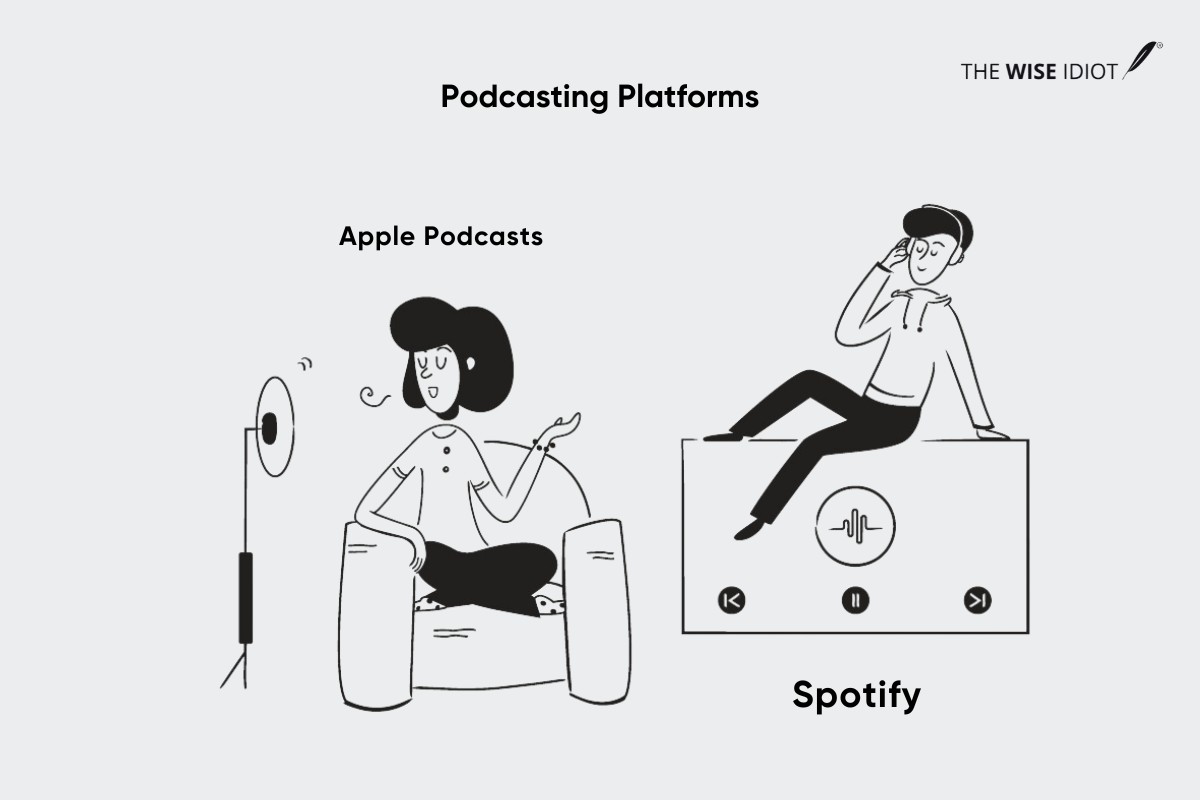
Apple Podcasts
Apple Podcasts can be used to publish regular podcast episodes on topics relevant to your audience, optimise your podcast titles and descriptions, and promote your episodes through social media and email newsletters.
Spotify
You can submit your podcast to Spotify for distribution, reaching a large user base of podcast listeners.
For example, a podcast dedicated to mindfulness and self-improvement can prioritise platforms like Apple Podcasts and Spotify to reach a wide audience of podcast listeners interested in personal growth topics.
5. Video Sharing Platforms
Platforms like YouTube, Vimeo, and TikTok are ideal for your video distribution strategy. Videos have a high engagement rate and can reach a broad audience. They are particularly effective for tutorials, product demonstrations, and storytelling. These are some common video distribution channels.
YouTube
You can upload and optimise videos, create playlists, engage with viewers through comments, and promote your videos through social media and other channels.
Vimeo
Sharing high-quality videos, creating private video collections, and embedding videos on your website or blog.
For example, a beauty brand offering makeup tutorials and product demonstrations can use YouTube and Vimeo to showcase its expertise visually, providing step-by-step tutorials and tips.
6. Content Aggregators
Websites like Reddit and Flipboard gather and curate content from various sources, making it easier for users to discover and consume content on specific topics. Sharing your content on these platforms can expose it to new audiences.
Your business can find relevant subreddits in your niche, participate in discussions, provide valuable insights, and share your content when it adds value to the conversation.
You can create magazines on Flipboard around specific topics and curate relevant content from various sources, including your own.
For instance, let’s say you run a small business that specializes in eco-friendly products. You can engage with the sustainability community on Reddit by contributing to relevant subreddits. Share tips on reducing waste and discuss the latest innovations in eco-friendly technology.
On Flipboard, curate a magazine focused on sustainable living, featuring content from a variety of sources that align with the larger conversation.
7. Online Communities and Forums
Engaging in online communities and forums relevant to your industry or niche can help you distribute content to a targeted audience. You can build credibility and drive traffic to your content by providing valuable insights and participating in discussions.
Quora
Quora helps you by answering questions related to your expertise, providing valuable insights, and including links to your content when relevant.
Stack Exchange
With Stack Exchange, you can participate in niche-specific communities and share knowledge and links to your content when it adds value to the discussion.
8. Influencer Marketing
Collaborating with influencers in your industry can help expand your content’s reach. Influencers have established audiences and can promote your content through their social media channels, blogs, or videos.

YouTube
You can collaborate with popular YouTubers in your industry to create sponsored videos that showcase your products or services.
With Instagram, you can partner with industry influencers to promote your brand through sponsored posts or Instagram takeovers, reaching their engaged audience.
For instance, a fintech brand can collaborate with finance influencers on platforms like YouTube, Instagram, or TikTok to promote themselves through sponsored videos, sponsored posts, or challenges, tapping into the influencer’s engaged audience.
9. Guest Posting
Pitch article ideas to established industry blogs and publications, contributing guest posts demonstrating your expertise and providing value to their audience. Include backlinks to your own content for increased exposure.
How to Choose the Best Distribution Channel for Your Brand?
Let us understand and compare the content distribution strategies and channels with the help of this table.
| Content Distribution Channel | Advantages | Disadvantages | Best Use Case |
| Social Media Platforms | Large user base, high engagement, diverse content formats. | Algorithms limit organic reach, and content can be buried in feeds. | Brand awareness, community building, and customer engagement. |
| Blogging Platforms | Long-form content, search engine optimisation, custom branding. | Requires consistent content creation and maintenance and may require technical skills for customisation. | Thought leadership, educational content, content marketing. |
| Email Marketing | Direct access to subscribers, personalised content, and high conversion rates. | Risk of being marked as spam requires an email list. | Newsletters, exclusive content, promotional offers. |
| Video Sharing Platforms | High engagement, diverse content formats, and shareable content. | Production costs, limited visibility without promotion. | Tutorials, product demonstrations, storytelling. |
| Podcasting Platforms | Convenient for on-the-go listening, high engagement, and niche audience. | Requires audio production skills and equipment, limited visibility without promotion. | Interview-style content, storytelling, educational content. |
| Content Aggregators | Exposure to new audiences, convenient content discovery, and user-generated content. | Limited control over content presentation may require active participation to gain visibility. | Trending topics, industry news, and user-generated content. |
| Online Communities and Forums | Niche audiences, high engagement, user-generated content. | Requires active participation and engagement, with the potential for negative feedback. | Thought leadership, networking, community building. |
| Influencer Marketing | Access to established audiences, high engagement, and third-party credibility. | It may require a significant investment and risks of influencer misconduct. | Product reviews, promotions, and brand awareness. |
| Content Syndication Platforms | Exposure to new audiences, sponsored content, and convenient distribution. | Limited control over the content presentation, potential for low-quality traffic. | High-quality content, evergreen content, promotional content. |
| Guest Posting | Access to established audiences, third-party credibility, and backlinks. | Requires pitching and approval from target publications, may not be effective for new or unknown brands. | Thought leadership, backlink building, and exposure to new audiences. |
Example of How to Use a Marketing Channel for Effective Content Distribution
Suppose you own a fintech company that primarily focuses on providing financial education and advice to young professionals and college students. Your goal is to engage with this audience and build brand awareness. In this case, Instagram could be a suitable channel for your fintech company.
Instagram allows you to share visually appealing content and reach a younger demographic that is active on the platform. Here’s how you can leverage Instagram as a content distribution channel.
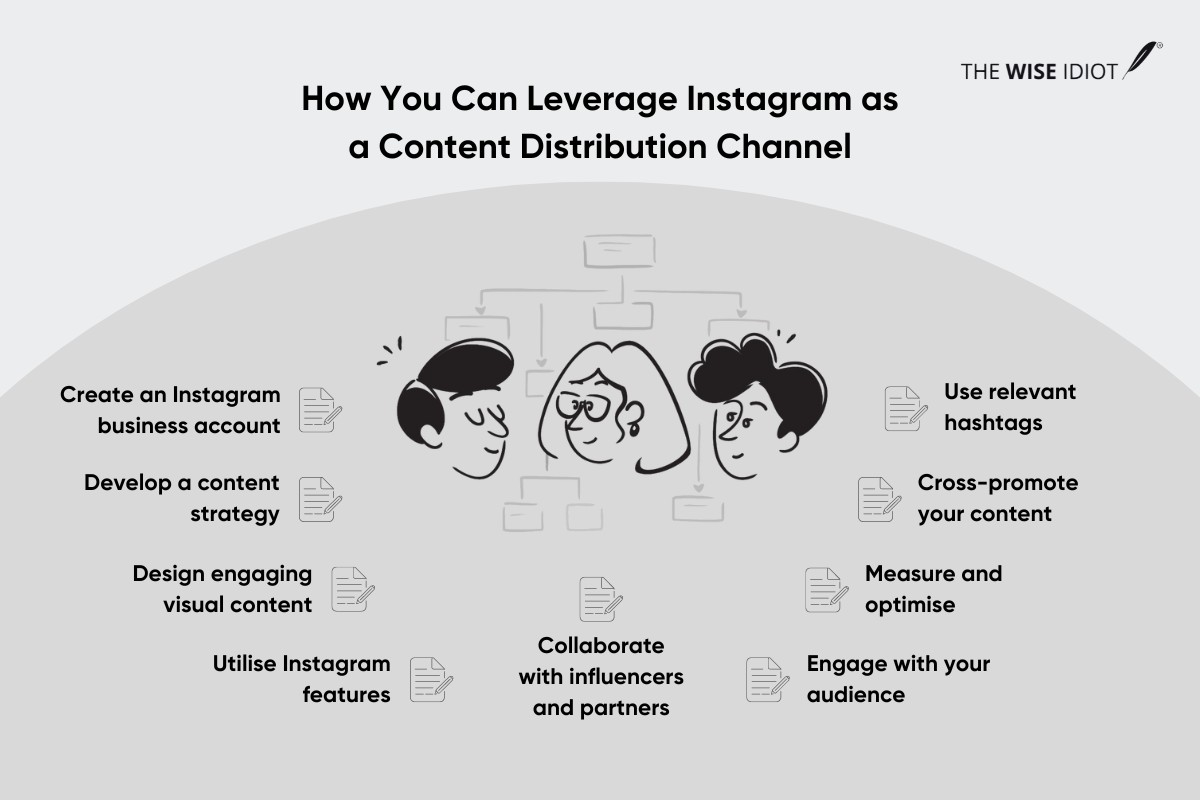
- Create an Instagram business account: Create a dedicated Instagram account for your fintech company. Make sure to optimise your profile by including a clear and concise bio that explains what your company offers.
- Develop a content strategy: Determine the type of content you want to share on Instagram. It could include visually appealing graphics, short educational videos, personal finance tips in the form of captions, or even stories that provide behind-the-scenes glimpses of your company.
- Design engaging visual content: Create eye-catching graphics and visuals that align with your brand identity. Use design tools or hire a graphic designer to create professional-looking images and videos. Consider using infographic-style posts to simplify complex financial concepts.
- Utilise Instagram features: Diversify your content by taking advantage of Instagram’s features like Stories, Reels, and Carousel posts. Stories can be used for daily updates, behind-the-scenes content, or quick tips, while reels can help showcase entertaining and informative content.
- Engage with your audience: Actively engage with your followers by responding to comments, direct messages, and mentions. Encourage conversations, answer questions, and address concerns related to personal finance. This will help build a community and establish trust with your audience.
- Collaborate with influencers and partners: Collaborate with influencers or partner with relevant brands, bloggers, or financial experts in your industry. This can help you tap into their existing audience and gain credibility through their endorsement or collaboration on content.
- Use relevant hashtags: Research and use relevant hashtags in your posts to increase discoverability and reach. Include hashtags related to personal finance, financial education, and topics that align with your content.
- Cross-promote your content: Promote your Instagram content on other platforms like your website, blog, or other social media channels. Encourage your audience to follow you on Instagram for exclusive content or live Q&A sessions.
- Measure and optimise: Use Instagram Insights or third-party analytics tools to monitor the performance of your content. Track metrics like engagement rate, follower growth, and reach to understand what resonates with your audience. Adjust your content strategy based on these insights to maximise effectiveness.
Remember, Instagram may be a suitable channel for your fintech company in this example, but it’s important to thoroughly research and analyse your target audience’s preferences and habits to make an informed decision about which channels will best serve your goals and reach your desired audience.
Tips on Choosing the Most Effective Distribution Channel
Here are some tips for you to choose the best channel for your digital content distribution strategy.
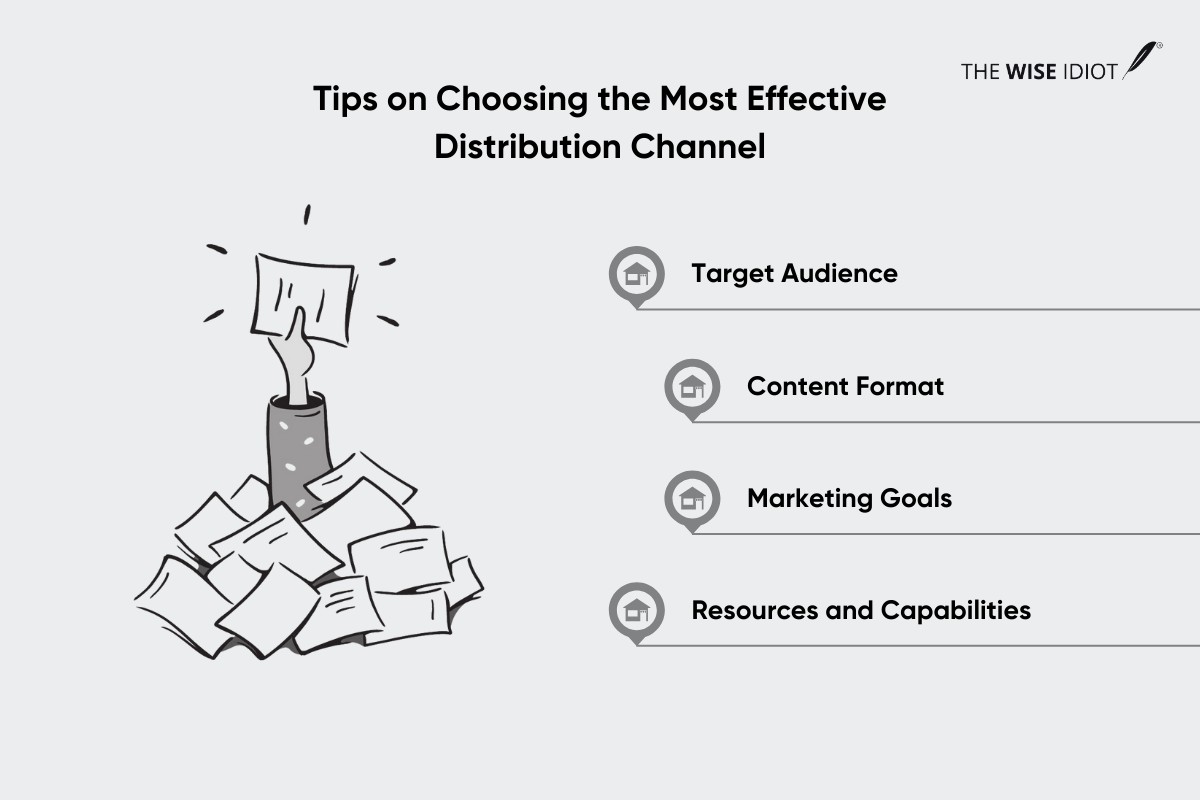
- Target Audience: Identify the platforms where your target audience is most active and engaged. For example, if your target audience consists of professionals and B2B connections, LinkedIn would be a suitable platform for sharing industry insights and articles. Platform platforms like Instagram or TikTok might be more effective if your content is highly visual and appeals to a younger demographic.
- Content Format: Different platforms support various content formats. Choose platforms that align with the type of content you create. For instance, if you produce engaging videos or tutorials, YouTube or TikTok would be suitable for video distribution. If you primarily create long-form written content, blogging platforms like WordPress or Medium are ideal for publishing articles.
- Marketing Goals: Determine your primary marketing goals and select platforms that align with those objectives. For example, if your goal is to increase brand awareness and reach a broad audience, social media platforms like Facebook or Twitter can help you achieve that. If you aim to establish thought leadership or provide educational content, blogging platforms and LinkedIn can support those goals.
- Resources and Capabilities: Consider the resources, skills, and time required to use a platform effectively. For example, if you have limited resources but can create compelling visual content, focusing on Instagram and leveraging relevant hashtags may be better than managing a blog.
Summary
It’s essential to tailor your content distribution strategy to your target audience and select the channels that align with their preferences and behaviours. Remember, the effectiveness of these channels may vary depending on your specific goals and target audience. It’s essential to evaluate your options carefully and choose the channels that align with your content strategy and marketing objectives.
Our team at The Wise Idiot strives to go above and beyond to ensure your content reaches its intended audience. We leverage and help you choose from various distribution channels, including social media platforms, email marketing, influencer partnerships, content syndication, and more. With our guidance, your content will not only engage and captivate your audience but also achieve maximum visibility and impact across the digital landscape. Contact us to unlock the true potential of content distribution and drive exceptional results for your business.
Frequently Asked Questions
Q1. How can you develop an effective content distribution strategy?
Ans: Craft a strategy aligning content with audience preferences, leverage diverse platforms, analyze data for optimization, and adapt based on performance metrics for continual improvement.
Q2. What is the most effective marketing channel?
Ans: The most effective marketing channel varies based on the target audience and campaign goals. Commonly used channels include social media, email marketing, content marketing, and search engine optimization (SEO).


